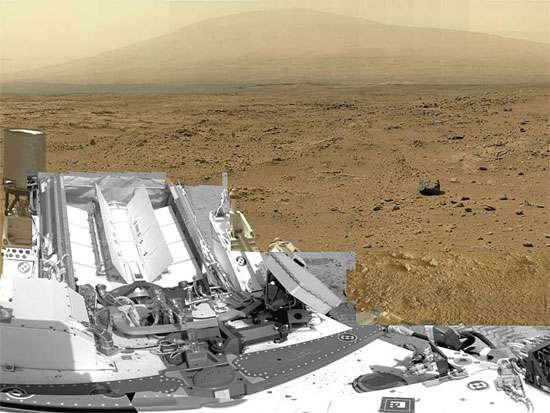Self-propelled vehicles take a panoramic view of Mars
NASA has published the first official images captured by the Curiosity autonomous vehicle, images that show the Martian surface in a clear detail to each crystal.
Among them is a surface photo around the location where Curiosity obtained the first sandblast. It is a land blown by the wind called 'rock nest' (Rock Nest) and extends to Sharp Mountain on the horizon.

Daily Mail quoted Bob Deen of NASA's Jet Propulsion Laboratory: "We can see the panorama and every single detail."
NASA's Mars Science Experiment Project is using a £ 2 billion, 6-wheel self-propelled self-propelled vehicle called Curiosity, with 10 scientific instruments to investigate the environmental history of the Gale volcanic region, The place where each discovery has favorable conditions for the life of bacteria. The Curiosity self-propelled vehicle has landed on Mars since August last year for a two-year mission. Now Curiosity will continue to analyze soil samples that contain all the ingredients needed for life.
Scientists have identified sulfur, nitrogen, hydrogen, oxygen, phosphorus and carbon in the sedimentary rock that Curiosity drills near an ancient spring in the Yellowknife Bay area in the Gale volcano. They believed that billions of years ago, water flowed from the volcanic rim and formed streams of nearly 1 meter depth.
The Daily Mail summarizes the project scientist John Grotzinger, 'We have found a peaceful and favorable living environment. You can drink this water . ' Michael Meyer, a scientist at NASA's NASA-based Mars discovery program, added: "A fundamental question for this task is whether Mars is a favorable living environment. And From what we know, the answer is yes. '
- Chance to Mars of Russia's NORD device
- Test of self-propelled Mars
- China's Moon self-propelled vehicles are weak
- Detecting traces of water on Mars
- 2025 is the year of self-propelled cars
- China launched the moon self-propelled vehicle
- Airbus is designing a self-propelled vessel to pick up the Martian specimen that is transported to Earth
- Video: Uber's 360-degree autopilot technology
- NASA develops a new generation self-propelled vessel to explore Mars by 2020
- Take a panoramic view of various web site interfaces
- Opportunity: A self-propelled self-propelled robot rolls 12 years on Mars
- Mars probe robots can fire lasers themselves
 Van Allen's belt and evidence that the Apollo 11 mission to the Moon was myth
Van Allen's belt and evidence that the Apollo 11 mission to the Moon was myth The levels of civilization in the universe (Kardashev scale)
The levels of civilization in the universe (Kardashev scale) Today Mars, the sun and the Earth are aligned
Today Mars, the sun and the Earth are aligned The Amazon owner announced a secret plan to build a space base for thousands of people
The Amazon owner announced a secret plan to build a space base for thousands of people